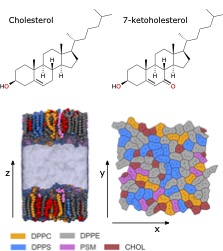Cholesterol plays a key role in the molecular and mesoscopic organisation of lipid membranes and it is expected that changes in its molecular structure (e.g., through environmental factors such as oxidative stress) may affect adversely membrane properties and function. In this study, we present evidence that oxidation of cholesterol has significant effects on the mechanical properties, molecular and mesoscopic organisation and lipid–sterol interactions in condensed monolayers composed of the main species found in the inner leaflet of the erythrocyte membrane. Using a combination of experimental methods (static area compressibility, surface dilatational rheology, fluorescence microscopy, and surface sensitive X-ray techniques) and atomistic molecular dynamics simulations, we show that oxidation of cholesterol to 7-ketocholesterol leads to stiffening of the monolayer (under both static and dynamic conditions), significant changes in the monolayer microdomain organisation, disruption in the van der Waals, electrostatic and hydrophobic interactions between the sterol and the other lipid species, and the lipid membrane hydration. Surface sensitive X-ray techniques reveal that, whilst the molecular packing mode is not significantly affected by cholesterol oxidation in these condensed phases, there are subtle changes in membrane thickness and a significant decrease in the coherence length in monolayers containing 7-ketocholesterol.
The results from this study provide evidence that cholesterol oxidation could have significant implications in terms of membrane organisation (on both molecular and mesoscopic levels), membrane physical properties, and degree of lateral order in lipid monolayers akin to the inner leaflet of the red blood cell. On a molecular level, these effects appear to stem from alterations in the distribution of hydrophilic (headgroup) and hydrophobic (tail) regions of the lipid monolayer containing different sterols as revealed by surface sensitive X-ray techniques. Complementary MD simulations of the same systems suggest that these alterations originate in the significant differences in which cholesterol and its oxidised variant, 7-ketocholesterol, interact with neighbouring lipid species. 7-ketocholesterol, due to its increased hydrophilicity, is able to draw water deeper in the headgroup region of the monolayer thus increasing its size. Oxidation of cholesterol also results in a decrease of the coherence length for these monolayers.
As a first step in understanding of these effects, we chose to work with mixtures of saturated-chain lipid species in order to emulate condensed lipid phases. Whilst our model lipid systems cannot capture the full molecular diversity of the mammalian plasma membrane, they should be representative of the condensed phases in the inner leaflet of the erythrocyte membrane, which are thought to form between cholesterol and saturated-chain lipids. Modifications of their properties as a result of oxidative stress may therefore have effects on such phases if they indeed exist in the inner leaflet, and lead to altered biological function. The obvious example is the membrane mechanical properties, which are of crucial importance especially for the erythrocyte. Increased membrane stiffness in terms of area compressibility (both static and dynamic) reported here complement existing studies that have shown that oxidative stress leads to increase of the membrane bending and shear stiffness and lipid packing.
Full reference: The effects of cholesterol oxidation on erythrocyte plasma membranes: A monolayer study. Bob-Dan Lechner, Paul Smith, Beth McGill, Skye Marshall, Jemma L. Trick, Andrei P. Chumakov, Charles Peter Winlove, Oleg V. Konovalov, Christian D. Lorenz & Peter G. Petrov, Membranes (2022) 12 (9), 828.

